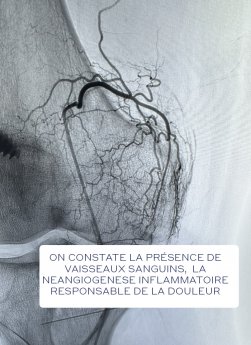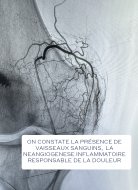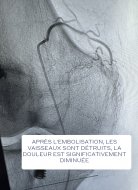Genicular Artery Embolization (GAE)
What does the minimally invasive endovascular treatment of knee osteoarthritis involve?
What is knee osteoarthritis?
Knee osteoarthritis (also known as degenerative joint disease, or DJD) is a very common disease caused by the wear and tear of the structures that form the knee joint, potentially leading to permanent joint damage. It affects 65 percent of adults aged 65 and over and is progressive, often presenting as flare-ups associated with a range of lesions:
- Gradual breakdown of the cartilage
- Shifting of the bones surrounding the joint
- Inflammation of the protective tissue (synovial membrane) that lines the inside of the joint capsule
This inflammation, called synovitis, is what causes the pain during an osteoarthritis flare-up. Clinical signs generally include pain, swelling in the joint, loss of range of motion and difficulty walking.
Basic medical treatment combines physical, dietary and lifestyle-related measures (weight loss, correcting an underlying deformity) and medication (nonsteroidal anti-inflammatory drugs). A local corticosteroid injection (cortisone shot) may also be proposed. Knee replacement surgery should only be proposed if first-line treatments fail.
What is genicular artery embolization?
Using modern image-guided techniques and latest-generation radiology equipment, a catheter is inserted into an artery in the patient’s leg, then threaded to the affected area of the knee.
A contrast dye is injected and an angiography is performed, providing images that identify the affected areas, in particular in the synovial membrane.
Still under X-ray guidance, tiny particles are injected to block the microarteries, thereby reducing blood flow to the inflamed area.
Once this step is completed, the catheter may be removed from the artery. A bandage is placed over the puncture site, and the procedure is over.
Who can benefit from genicular artery embolization?
The patients most likely to benefit from GAE are those who have suffered for at least six months from moderate to severe arthritis in the knee that resists appropriately administered medical treatment combining physical (rehabilitation), dietary and lifestyle-related measures, and possibly corticoid injections.
What happens during genicular artery embolization?
The main cause of an osteoarthritis flare-up is inflammation of a synovial membrane, which is part of the capsule that surrounds each joint in the body.
This inflammation causes the joint to swell (joint effusion), which in turn generates inflammation associated with hypervascularity. This creates a vicious cycle leading to ever increasing inflammation and vascular hypertrophy, eventually causing permanent damage to the joint.
The aim of embolization is to block some of the vessels that supply blood to the joint capsule. Reducing blood supply alleviates the inflammation, helping to break the vicious cycle of inflammation and damage and thereby improve symptoms.
What to expect during genicular artery embolization at the American Hospital of Paris
Prior to the procedure, you will meet with an interventional radiologist and an anesthesiologist for a consultation.
The procedure itself lasts between one and two hours.
Once the procedure is over, you will be monitored for three hours in ambulatory care before returning home.
Your total length of stay therefore will not exceed half a day.
Rehabilitation after the procedure is rapid. Patients are able to return to normal activity the same day. No wound care is required. The first improvements resulting from the procedure are generally noticeable after three days.
What are the outcomes of GAE?
After the embolization procedure, symptoms significantly improve in 80 to 85 percent of cases.
In particular, studies show a major improvement of the scores relating to pain, physical function (WOMAC score) and quality of life.
Little information about this innovative technique has been published in the scientific literature. However, two recently published randomized trials confirm the benefits of GAE.
In the first multicenter double-blind trial, participants’ pain scores (Visual Analogue Scale) and WOMAC physical function scores went down by at least 50 percent. These results were obtained one year after the GAE procedure, thus indicating a long-term result. (Source)
A second randomized trial produced similar findings, with the WOMAC score down 61 percent and the VAS pain score down 67 percent one year after the embolization procedure (Source).
What are the side effects of GAE?
The rate of major complications is next to zero.
A few minor complications may occur.
20 percent of patients may experience a temporary modification of the knee’s skin color, combined with some pain. This effect is caused by the drop in blood flow and will resolve on its own within a few days, with no need for treatment.
Hematoma may also occur at the puncture site in the femoral artery (groin). In most cases, only simple monitoring is required.
Should symptoms recur, a second embolization procedure remains possible. Moreover, the embolization procedure does not preclude subsequent treatments such as a joint injection or surgery.
Make an appointment with our interventional radiologists
Learn more


